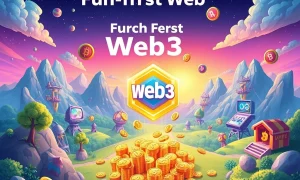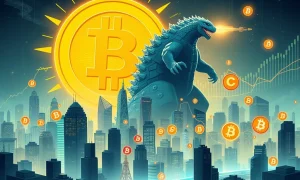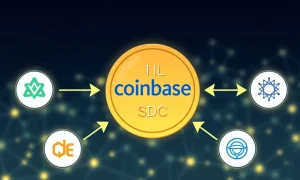The cryptocurrency market often presents intriguing paradoxes. Recently, a significant shift has emerged, capturing the attention of investors and enthusiasts alike. While decentralized finance (DeFi) platforms reached unprecedented liquidity levels, fueled by the burgeoning interest in tokenized stocks, a striking divergence in user engagement became apparent. Reports indicate that despite DeFi’s record-breaking financial metrics, NFT user activity surged, drawing more daily active wallets than DeFi in July. This surprising trend prompts a closer look at where real engagement is happening within the digital asset ecosystem. Understanding this dynamic is crucial for anyone navigating the evolving landscape of Web3.
DeFi’s Remarkable Growth: Fuelled by Tokenized Stocks
Decentralized finance continues its impressive expansion. In July, the total value locked (TVL) in DeFi protocols soared to a record $270 billion. This represented a substantial 30% month-over-month increase. A key driver behind this remarkable growth was the increasing popularity of tokenized stocks. These digital assets, representing traditional equities on the blockchain, attracted significant attention.
Specifically, active wallets for tokenized stocks witnessed an exponential rise. They jumped from approximately 1,600 to over 90,000 within the month. Consequently, their market capitalization surged by an astonishing 220%. This highlights a growing appetite for innovative financial products within the DeFi space. Tokenized stocks offer several advantages. For instance, they provide fractional ownership, increased liquidity, and 24/7 trading access. Furthermore, they bridge the gap between traditional finance and blockchain technology. This integration makes them particularly appealing to a broader investor base seeking diversified digital asset portfolios.
The record TVL in DeFi signifies robust confidence in its underlying infrastructure. It also demonstrates the increasing utility of its various protocols. However, liquidity does not always directly translate to broad user interaction. This distinction is vital for understanding the broader market trends.
The Ascendance of NFT User Activity
Despite DeFi’s financial milestones, user attention shifted notably towards non-fungible tokens (NFTs). In July, NFT DApps attracted approximately 3.85 million of the 22 million daily active wallets. This figure slightly surpassed the number of active wallets engaging with DeFi protocols. This indicates a significant pivot in where daily active users choose to spend their time and resources within the Web3 ecosystem. The surge in NFT user activity reflects a renewed interest in digital collectibles and unique digital assets.
Moreover, NFT trading volumes experienced a substantial boost. They jumped 96% to $530 million during July. The average NFT price also doubled, reaching around $105. This suggests that more users actively engaged with the NFT market, driving both volume and value. Several platforms spearheaded this resurgence. Ethereum-based marketplace Blur, for example, captured up to 80% of daily NFT volume. Meanwhile, OpenSea maintained its position as a leading platform, topping active users with roughly 27,000 traders. Another notable player, Zora, gained momentum with its creator-first Layer 2 solution and the introduction of its $ZORA token. This token facilitates low-cost minting, making NFT creation more accessible to artists and creators.
The increased NFT user activity is not just about trading. It also reflects a broader cultural adoption. Many users are drawn to NFTs for their community aspects, artistic expression, and potential for future utility. This diverse appeal contributes to their growing prominence.
Major Brands Embrace the NFT Phenomenon
The growing appeal of NFTs extends beyond individual collectors and digital artists. Major global brands are increasingly experimenting with these digital assets. Their involvement further validates the technology and broadens its reach. These collaborations demonstrate a strategic move by established companies to engage with Web3 technologies and their vast audiences.
For instance, Nike.SWOOSH partnered with EA Sports. This collaboration aimed to launch virtual sneaker drops, blending digital fashion with gaming. Such initiatives create unique interactive experiences for consumers. Similarly, luxury brands like Louis Vuitton and Rolex have explored NFTs. They launched authentication and collectible pilots, leveraging blockchain for verifiable ownership and exclusive digital assets. Coca-Cola (China) also joined this trend, experimenting with collectible NFTs. These moves highlight the versatility of NFTs. They serve as more than just art; they function as tools for brand engagement, authenticity, and loyalty programs. The participation of such prominent brands underscores the potential for NFTs to integrate into mainstream commerce and culture. It signals a shift from niche interest to broader acceptance.
NFT Market Dynamics and the Resurgence of OG Collections
Despite the notable rebound in July, the NFT market still operates below its peak performance from previous years. The trading volume, while up from June, was still down from its past peak of $997 million in early 2024, as reported by DappRadar. This indicates that while interest is returning, the market has not yet fully recovered to its euphoric highs. Nevertheless, the recent surge in NFT user activity provides a hopeful sign for sustained growth.
A fascinating aspect of the recent rebound is the renewed interest in “OG” NFT collections. CryptoPunks, an Ethereum-based collection, experienced a significant resurgence. Data from NFT Floor Price showed the collection was up over 25% in the past month. In fact, during one 24-hour period, nine of the top 10 NFT sales were CryptoPunks. The sole non-Punk sale was an NFT from the Web3 artist Beeble. This renewed focus on established, historically significant collections suggests a maturing market. Investors and collectors are increasingly valuing scarcity and provenance. This trend could indicate a flight to quality within the NFT space. It reflects a desire for assets with a proven track record and cultural significance.
However, the broader picture for NFTs in 2024 remains challenging. DappRadar’s industry overview reported a 19% year-over-year drop in NFT trading volume. Sales counts also declined by 18%. This makes 2024 one of the weaker years since 2020. CryptoSlam data for the first half of 2024 further underscores this slow recovery. NFT sales totaled $2.82 billion, down 4.6% from the second half of 2023. While July provided a much-needed boost, the market is still considerably below its 2021 highs. Back then, trading volumes ran into the tens of billions of dollars. This context is important when assessing the recent surge in NFT user activity.
Understanding the Market Contradiction: Liquidity vs. User Engagement
The concurrent rise in DeFi liquidity and the shift in user activity towards NFTs present an intriguing market dynamic. On one hand, DeFi’s record TVL signals robust capital inflow and confidence in decentralized financial services. This liquidity supports lending, borrowing, and various yield-generating opportunities. It often attracts institutional players and large capital holders seeking passive returns or efficient financial tools. On the other hand, the surge in NFT user activity suggests that retail users and those seeking direct interaction, community, and cultural experiences are gravitating towards digital collectibles.
This apparent contradiction can be understood by considering different user motivations. DeFi typically appeals to users focused on financial utility, asset management, and investment strategies. These users might not be daily active participants in the same way an NFT collector or gamer might be. Their interaction could involve deploying capital for longer periods. Conversely, NFTs and Web3 DApps often involve more frequent, short-term interactions. These include browsing marketplaces, participating in drops, engaging with communities, and playing blockchain games. The lower barrier to entry for many NFT experiences also contributes to higher user numbers. Therefore, while DeFi holds significant capital, NFTs capture the attention and daily engagement of a broader user base. This highlights a segmentation within the crypto ecosystem, catering to distinct user needs and preferences.
The distinction between locked value and active participation is crucial. High TVL indicates trust in the protocols’ security and profitability. However, high active user counts point to widespread adoption and engagement with the applications themselves. Both metrics are important indicators of ecosystem health, but they reflect different aspects of growth.
The Road Ahead for Digital Assets
The evolving landscape of DeFi and NFTs suggests a dynamic future for digital assets. The growth of tokenized stocks within DeFi indicates a maturation of decentralized finance. It is expanding beyond speculative trading into more structured financial instruments. This development could attract even more traditional investors to the blockchain space. Furthermore, the sustained interest and rising NFT user activity demonstrate the enduring appeal of digital ownership and cultural expression in Web3.
Looking forward, we may see increased convergence between these two sectors. For example, NFTs could be used as collateral in DeFi protocols, or DeFi primitives could be integrated into NFT marketplaces. Such innovations would create more sophisticated and interconnected digital economies. The market is continually adapting, driven by innovation and shifting user preferences. The ability of both DeFi and NFTs to attract significant capital and user engagement, respectively, bodes well for the overall health and diversification of the crypto market. Ultimately, these trends underscore the increasing complexity and opportunity within the decentralized world.
Frequently Asked Questions (FAQs)
Q1: What is the significance of DeFi’s record $270 billion TVL?
A1: The record $270 billion Total Value Locked (TVL) in DeFi signifies strong investor confidence and increased capital flowing into decentralized financial protocols. It indicates robust liquidity, supporting various services like lending, borrowing, and yield farming, and suggests a maturing financial infrastructure.
Q2: Why did active wallets for tokenized stocks soar in July?
A2: Active wallets for tokenized stocks soared due to their appeal in bridging traditional finance with blockchain. They offer benefits like fractional ownership, 24/7 trading, and increased liquidity for traditional equities, attracting a broader investor base seeking diversified digital asset portfolios.
Q3: How did NFT user activity compare to DeFi in July?
A3: In July, NFT DApps drew slightly more active users than DeFi, with approximately 3.85 million daily active wallets compared to DeFi’s user base. This indicates a notable shift in where daily active users are engaging within the Web3 ecosystem, despite DeFi holding significantly more liquidity.
Q4: Which platforms drove the increase in NFT trading volume?
A4: Ethereum-based marketplace Blur drove much of the NFT trading volume, capturing up to 80% of daily volume. OpenSea remained a leader in active users, while Zora gained momentum with its creator-first Layer 2 solution and low-cost minting options, contributing to the overall surge in NFT user activity.
Q5: Are NFTs still far from their 2021 boom levels?
A5: Yes, despite a strong rebound in July, NFT trading volumes and sales counts in 2024 are still significantly below their 2021 highs, when volumes ran into the tens of billions. The market is showing signs of recovery but has not yet reached past euphoric peaks.
Q6: Why are major brands experimenting with NFTs?
A6: Major brands like Nike, Louis Vuitton, Rolex, and Coca-Cola are experimenting with NFTs to engage with Web3 audiences, enhance brand loyalty, provide unique digital experiences (e.g., virtual sneakers), and leverage blockchain for authentication and exclusive collectibles. This broadens NFT utility beyond just art.
























